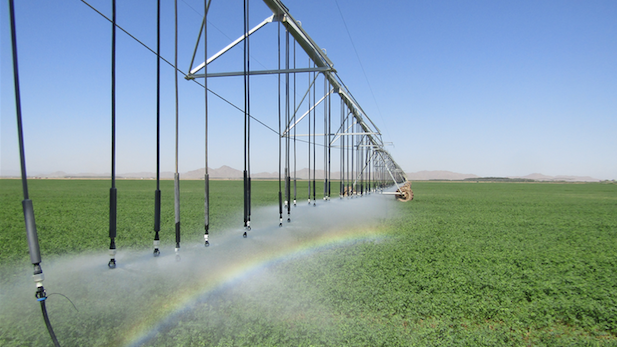
By Casey KUHN, KJZZ Radio
Sprinklers are watering organic potatoes on a farm on the Ak-Chin Indian Community in Pinal County/
It's a test field using an uncommon technology for Arizona farms, called central pivot sprinklers. It uses about 30 percent less water per acre, farm manager Steve Coester said.
Coester said watering techniques have been modernized on about half their fields to allow the Ak-Chin to use their allocated water as efficiently as possible
“And now we’re starting to move toward sprinkler irrigation and drip irrigation, as a matter of just conserving water," he said. "Plus it’s much more efficient and yields are increasing.”
Most Arizona farmland still uses flood irrigation. Coester said the reason farmers are reluctant to switch is that installing new systems is expensive, sometimes up to $1,000 more per acre.
Alyssa Garcia, a young member of the tribe and former Miss Indian Arizona, works on the Ak-Chin farm for the summer. She said carrying on the old farming traditions with new technologies is important to her.
“We’ve been able to really allocate our water and use it as efficiently as we can because it is a sacred resource to us,” Garcia said.
Garcia works with Leona Kakar who flipped through a copy of the water rights settlement between the Ak-Chin and the federal government, which she fought for in 1983.
“I think there’s just two of us still alive,” she said, looking for the short list of signatures on the settlement in which she was included.
The settlement work started when she was told the Ak-Chin had to create a council to represent its water interests, so she did. And then she was told she had to fly to Washington, D.C., to negotiate, so she did.
And then, she wouldn’t budge on asking for 50,000 extra acre-feet of water to be guaranteed by the federal government. She said negotiations were tense.
“Oh we waited, and we waited, I was getting so nervous and one of them said, 'Well, we’ve discussed this, and we’ve decided and we’ll go ahead and give you the 50,000 extra,'" she said. "Oh, I was so relieved!”
That boost allowed the community to go from 3,000 to 15,000 acres of farmland, including corn, pecans and cotton.
Down the street from Ak-Chin, at the U.S. Department of Agriculture Arid Land Agriculture Research Center, scientist Kelly Thorp is studying exactly how much more efficient the sprinklers are.
“We have a diesel engine on board this little cart, running a pump, pulling water out of the canal and delivering it up onto the top pipe running along the lateral above us,” Thorp said.
He was standing in a field being irrigated with an high-tech overhead sprinkler system. As the little green cotton sprouts grow, he will measure whether there will be more crop with less water.
For the next generation of crops, these findings could be crucial because of water restrictions.
“Right here in Pinal, I think people are going to get their water cut back next year. Unless something changes, you know,” Coester said.
After 50 years working and managing the farmland, Kakar is ready to turn over the reins. “I’ve done my part, from the ground up," she said. "I did my part getting water here.”
In a university study, sprinkler irrigation in California has had positive results on almost every crop tested. So the Ak-Chin community may be ahead of the game when it comes to efficient crop watering in Arizona.

By submitting your comments, you hereby give AZPM the right to post your comments and potentially use them in any other form of media operated by this institution.